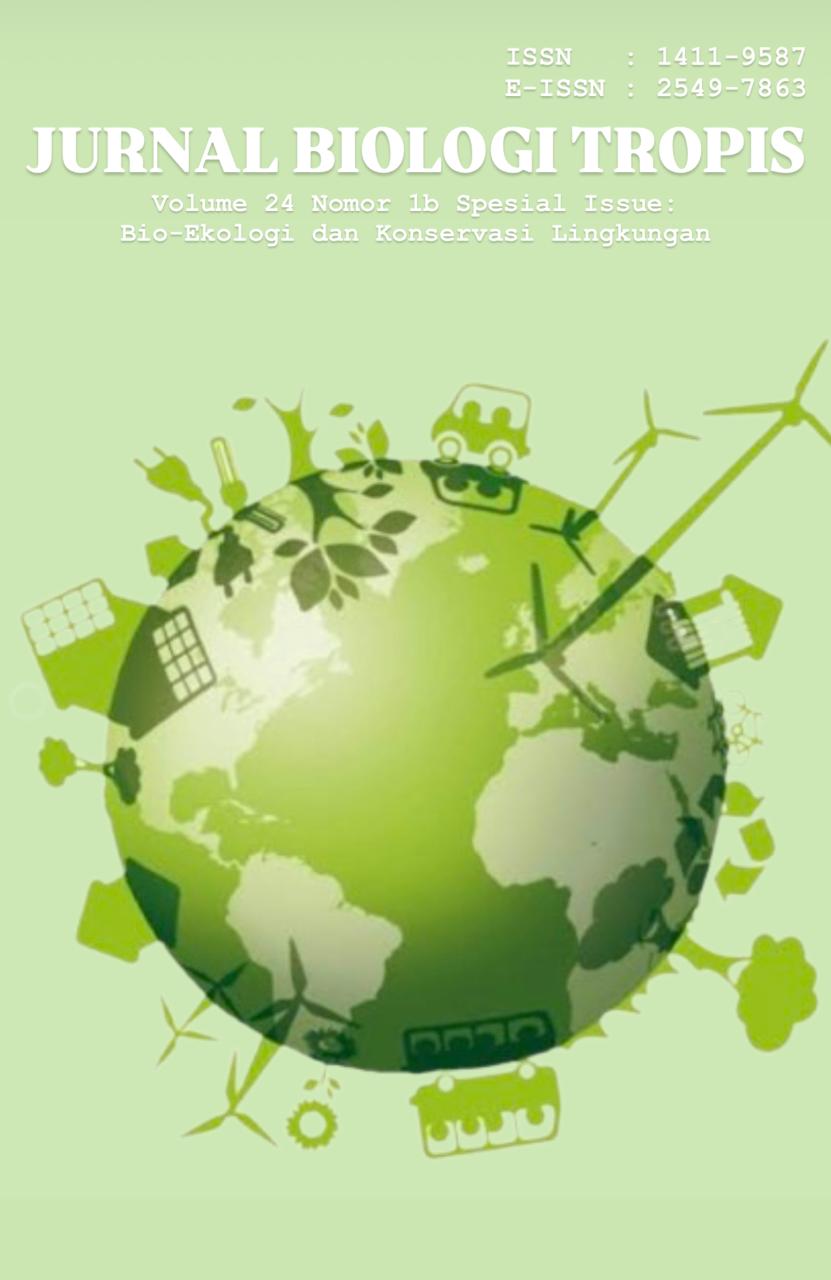Relationship between Gastropod Abundance and Total Organic Material (BOT) Sediments in Mangrove Habitats in Gambesi Village, South Ternate District, Ternate City
Authors
S. Nurul K. Sembel , Mesrawaty Sabar , Rusmawati La Benua , Riyadi Subur , Mohammad Abjan Fabanjo , Ardan SammanDOI:
10.29303/jbt.v24i2b.7867Published:
2024-12-24Issue:
Vol. 24 No. 2b (2024): Special IssueKeywords:
Abundance, BOT, Gambesi Village, gastropods, manggrove ecosystem.Articles
Downloads
How to Cite
Downloads
Metrics
Abstract
In the mangrove ecosystem there are many gastropods which are one of the biological resources. As a habitat, Gastropods have high diversity and occupy the mangrove ecosystem. Organic detritus gets food supply through mangrove forests and makes an important contribution as the main source of food for biota living in the surrounding waters. The purpose of the study was to determine the diversity and abundance of gastropods, determine the concentration of total organic matter (BOT), analyze the relationship between the abundance of gastropods and total organic matter (BOT) in the sediment in the mangrove habitat and determine the condition of water quality at the research location of the coastal mangrove habitat of Gambesi Village. This study uses qualitative and quantitative methods. Sampling of gastropods was carried out using a block area measuring 20 x 20 m², which was carried out at low tide. The data analysis methods used were gastropod abundance, diversity index, organic matter content, simple linear regression. The results of the analysis of the highest gastropod abundance were at station 2 for the Terebralia sulcata species of 48 individuals and the lowest were at station 1 for the Nerita polita species of 3 individuals. The diversity index of station 1 is H’= 1.80 and station 2 is H’= 1.83, included in the medium diversity category. Station 1 sediment organic matter content is 34.20% in the high category and station 2 is 49.50% in the very high category. According to the simple regression test value, the correlation coefficient value ranges from around 0.8 <r ≤ 1.0 which proves that the abundance of gastropods has a large correlation with the organic matter content in the sediment.
References
Anita, Y. (2018). Komposisi dan Kelimpahan Gastropoda serta Hubungannya dengan Mangrove di Kawasan Sari Ringgung Kabupaten Pesawaran, Lampung.
Ayu, D. M., Ary, S. N., & Rivanna, C. R. (2015). Keanekaragaman gastropoda sebagai bioindikator pencemaran lindi TPA Jatibarang di Sungai Kreo Kota Semarang. In Seminar Nasional XII Pendidikan Biologi FKIP UNS, Solo.
Ayunda, R. (2011). Struktur Komunitas Gastropoda pada Ekosistem Mangrove di Gugus Pulau Pari, Kepulauan Seribu. Skripsi. Program Studi Biologi Fakultas Matematika dan Ilmu Pengetahuan Alam Universitas Indonesia. Depok.
Bashir, I., Lone, F. A., Bhat, R. A., Mir, S. A., Dar, Z. A., & Dar, S. A. (2020). Concerns and threats of contamination on aquatic ecosystems. Bioremediation and biotechnology: sustainable approaches to pollution degradation, 1-26.
Sinu, J. V. (2022). Source and composition of organic matter and its role in sediment benthic communities. In Ecology and Biodiversity of Benthos (pp. 83-133). Elsevier. 10.1016/b978-0-12-821161-8.00001-5
Dewiyanti, I. (2004). Struktur Komunitas Moluska (Gastropoda dan Bivalvia) Serta Asosianya Pada Ekosistem Mangrove di Kawasan Pantai Ulee-Lheue, Banda Aceh, NAD.
Effendi, H. (2003).Telaah Kualitas Air Bagi Pengelolaan Sumberdaya Dan Lingkungan Perairan. Yogyakarta : Kanisius.
Fachrul, M. F. (2007). Metode Sampling Bioekologi. Jakarta.
Faizal, A., Jompa, J., Nessa, N., & Rani, C. (2012, July). Dinamika spasio-temporal tingkat kesuburan perairan di Kepulauan Spermonde, Sulawesi Selatan. In Seminar Nasional Tahunan IX Hasil Penelitian Perikanan dan Kelautan.
Febrita, E., Darmawati, D., & Astuti, J. (2015). Keanekaragaman Gastropoda dan Bivalvia hutan mangrove sebagai media pembelajaran pada konsep keanekaragaman hayati Kelas X SMA. Jurnal Biogenesis, 11(2), 119-128.
Ghufron, H. K., & Kordi, K. M. (2012). Ekosistem Mangrove: Potensi, Fungsi Dan Pengelolaannya. Jakarta: Rineka Cipta.
Heiri, O., Lotter, A. F., & Lemcke, G. (2001). Loss on ignition as a method for estimating organic and carbonate content in sediments: reproducibility and comparability of results. Journal of paleolimnology, 25, 101-110.
Hidayanto, M., & Yossita, F. (2004). Analisis tanah tambak sebagai indikator tingkat kesuburan tambak. Jurnal pengkajian dan pengembangan teknologi pertanian, 7(2), 124574.
Irawan, I. (2008). Struktur Komunitas Moluska (Gastropoda dan Bivalvia) serta Distribusinya di Pulau Burung dan Pulau Tikus, Gugusan Pulau Pari, Kepulauan Seribu. Jurnal Departemen Biologi FMIPA, Institut Pertanian Bogor, Bogor.
Irmawan, R. N., Zulkifli, H., & Hendri, M. (2010). Struktur Komunitas Makrozoobentos di Estuaria Kuala Sugihan Provinsi Sumatera Selatan. Maspari Journal: Marine Science Research, 1(1), 53-58.
Karimah, K. (2017). Peran ekosistem hutan mangrove sebagai habitat untuk organisme laut. Jurnal Biologi Tropis, 51-57. http://dx.doi.org/10.29303/jbt.v17i2.406.
Karyanto, P., MARIDI, M., & INDROWATI, M. (2004). Variasi cangkang gastropoda ekosistem mangrove Cilacap sebagai alternatif sumber pembelajaran moluska; gastropoda. Bioedukasi: Jurnal Pendidikan Biologi, 1(1), 1-6.
[KEPMENLH] Keputusan Menteri Negara Lingkungan Hidup. 2004. Nomor: 51. Kriteria Baku Mutu Kualitas Air untuk Biota. Jakarta.
Maretta, G., Hasan, N. W., & Septiana, N. I. (2019). Keanekaragaman Moluska di Pantai Pasir Putih Lampung Selatan. Biotropika: JTB, 7(3), 87–94.
Sabar, M., Samman, A., Serosero, R. H., & Kadir, M. A. (2022). Mangrove Species Density and Dynamics of Nitrate (NO3) on Sediments in the Manumadehe Island, South Jailolo District, West Halmahera Regency. Agrikan Jurnal Agribisnis Perikanan, 15(2), 370-380.
Amrul, H. M. Z. Kualitas Fisika-Kimia Sedimen dan Hubungannya Terhadap Struktur Komunitas Makrozoobentos di Estuari Percut Sei Tuan Kabupaten Deli Serdang (Doctoral dissertation, Bogor Agricultural University (IPB)).
Nyabakken J. W. (1992). Biologi Laut. Suatu Pendekatan Ekologis. Penerbit: PT. Gramedia Pustaka Utama, Jakarta.
Odum. (1996). Dasar-dasar Ekologi. (Terjemahan). Yogyakarta: Gajah Mada University Press.
Puspitasari, N. (2012). Keanekaragaman Makrozoobenthos di Perairan Desa Malang Rapat Kecamatan Gunung Kijang Kabupaten Bintan Provinsi Kepulauan Riau. Skripsi. Universitas Maritim raja Ali Haji. Tanjungpinang.
Rahmat, Rivaldi., Syafruddin, Nasution., Efriyeldi, Efriyeldi. (2024). Gastropoda community structure in the mangrove forest of Ketapang Coastal Waters, Rupat District. 10.61761/seamas.1.2.38-48
Romdhani, A. M., & Sukarsono, S. R. (2016). Keanekaragaman gastropoda hutan mangrove Desa Baban Kecamatan Gapura Kabupaten Sumenep sebagai sumber belajar biologi. Jurnal Pendidikan Biologi Indonesia, 2(2), 161-167.
Rositasari, R. (2020). Ancaman hipoksia bagi ekosistem pesisir; penggunaan indeks Ammonia-Elphidium (AE) sebagai proksi. OSEANA, 45(1), 82-92.
Samir, W. N., & Romy, K. (2016). Studi kepadatan dan pola distribusi bivalvia di kawasan mangrove Desa Balimu Kecamatan Lasalimu Selatan Kabupaten Buton. Jurnal Manajemen Sumber Daya Perairan, 1(2), 169-181.
Satria, M., Zulfikar, A., & Zen, L. W. (2014). Keanekaragaman dan Distribusi Gastropoda di Perairan Desa Berakit Kabupaten Bintan. Skripsi. Fakultas Kelautan dan Perikanan. UMRAH. Tanjung pinang.
Tambayong, F. A., Rudiyanti, S. & Surynti. (2016). Hubungan Kandungan Bahan Organik dengan Distribusi dan Keanekaragaman Gastropoda pada Ekosistem Mangrove di Desa Pasar Banggi Kabupaten Rembang. Universitas Diponegoro
Taqwa R. N., M. R. Muskananfola, & Ruswahyuni. (2014). Studi Hubungan Substrat Dasar dan Kandungan Bahan Organik Dalam Sedimen Dengan Kelimpahan Hewan Makrobhentos di Muara Sungai Sayung Kabupaten Demak. Jurnal 0f Menagement of Aquatic Resources, 3 (1) : 125 – 133.
Vinh, T. V., Allenbach, M., Linh, K. T. V., & Marchand, C. (2020). Changes in leaf litter quality during its decomposition in a tropical planted mangrove forest (Can Gio, Vietnam). Frontiers in Environmental Science, 8, 10.
Wijayanti, H. (2007). Kualitas Perairan di Pantai Kota Bandar Lampung Berdasarkan Komunitas Hewan Makrobenthos. Tesis Magister Sains, Program Pascasarjana, Universitas Diponegoro, Semarang.
Yanto, Rudi. (2016). Keanekaragaman Gastropoda pada Ekosistem Mangrove Pantai Masiran Kabupaten Bintan. Jurnal Ilmu Kelautan. FIKP Umrah.
Yunitawati., Sunarti, & Z,. Hasan. (2012). Hubungan antara kerakteristik Substrak dengan Struktur Komunitas Makrozoobenthos di Sungai Cantiga, Kabupaten Indramayu . Jurnal Perikanan dan Kelautan, 3 (3); 221-227. 2012
Vadeboncoeur, Y., & Lowe, R. (2024). Benthic Algae and Cyanobacteria of the Littoral Zone. In Wetzel's Limnology (pp. 817-857). Academic Press. 10.1016/b978-0-12-822701-5.00025-2
License
Copyright (c) 2024 S. Nurul K. Sembel, Mesrawaty Sabar, Rusmawati La Benua, Riyadi Subur, Mohammad Abjan Fabanjo, Ardan Samman

This work is licensed under a Creative Commons Attribution 4.0 International License.

Jurnal Biologi Tropis is licensed under a Creative Commons Attribution 4.0 International License.
The copyright of the received article shall be assigned to the author as the owner of the paper. The intended copyright includes the right to publish the article in various forms (including reprints). The journal maintains the publishing rights to the published articles.
Authors are permitted to disseminate published articles by sharing the link/DOI of the article at the journal. Authors are allowed to use their articles for any legal purposes deemed necessary without written permission from the journal with an acknowledgment of initial publication to this journal.


























